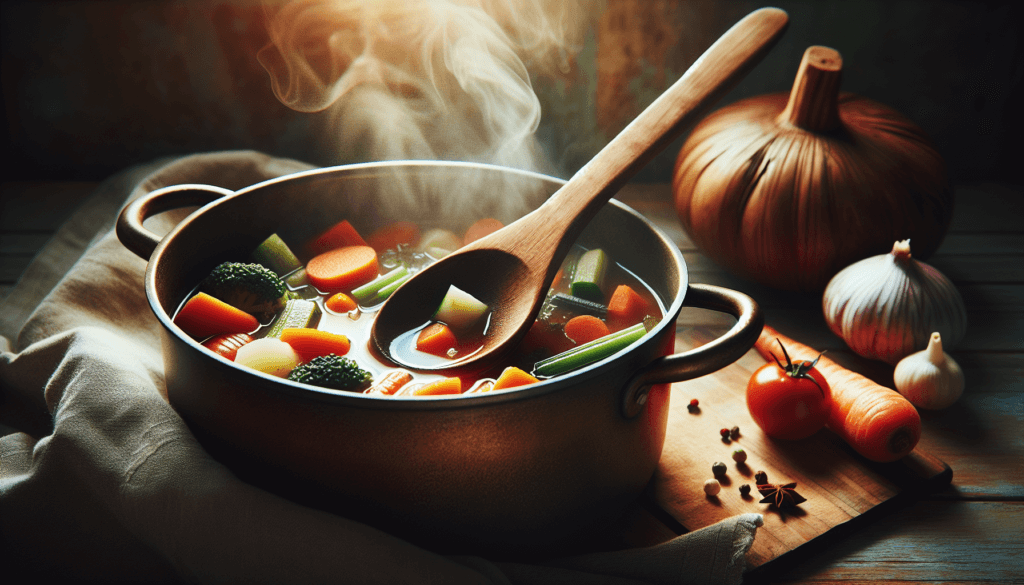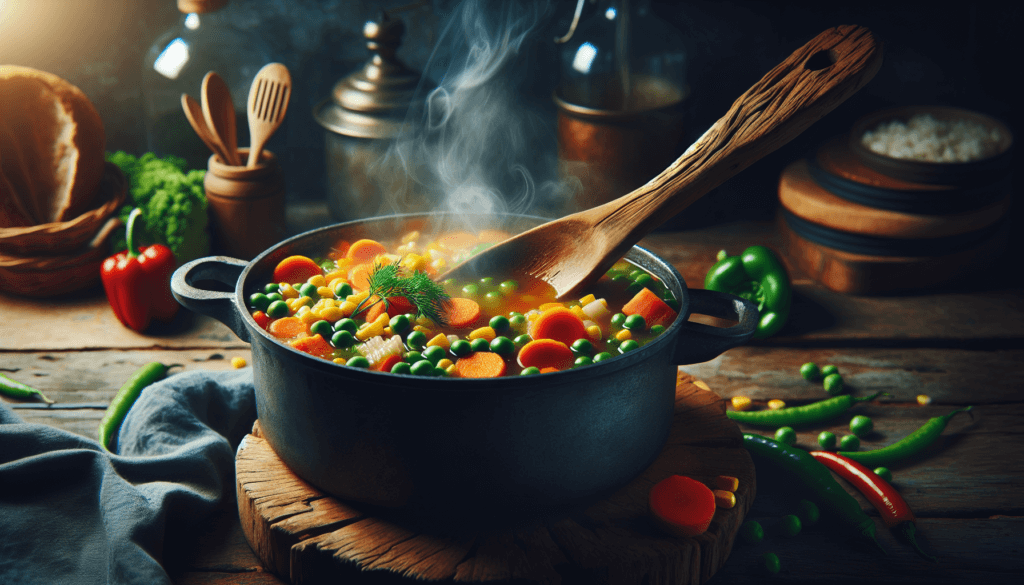Imagine the warmth and comforting aroma of a homemade pot of hearty vegetable soup simmering on your stove on a chilly evening. The thought alone makes your taste buds tingle with anticipation. But where do you even begin? Don’t worry, we’ve got you covered. In this article, you’ll discover all the steps and ingredients needed to create a delicious bowl of nourishing vegetable soup from scratch. Say goodbye to canned soup and hello to the satisfaction of cooking a wholesome and flavorful meal that will keep you cozy all season long.

Choosing Vegetables
Selecting Seasonal Vegetables
When it comes to choosing vegetables for your homemade pot of hearty vegetable soup, it’s essential to prioritize seasonal produce. Seasonal vegetables not only taste better but also tend to be more affordable and readily available. In addition, seasonal vegetables are packed with nutrients since they are picked at their peak ripeness. Keep an eye out for vegetables like butternut squash, carrots, kale, and Brussels sprouts in the fall and winter months, while bell peppers, tomatoes, zucchini, and corn shine during the summer.
Choosing a Variety of Vegetables
To make your vegetable soup more flavorful and nutritious, it’s important to choose a variety of vegetables. By incorporating different types of vegetables, you can create a harmonious balance of flavors and textures. Consider using a mix of root vegetables, such as carrots, potatoes, and parsnips, for a hearty and grounding soup base. Add leafy greens like spinach or kale for a burst of freshness and a boost of vitamins and minerals. Don’t forget about adding some cruciferous vegetables like broccoli or cauliflower, which not only bring a delightful crunch but also provide additional health benefits.
Organic vs. Conventional Vegetables
When it comes to choosing between organic and conventional vegetables for your homemade soup, it ultimately comes down to personal preference and budget. If you have access to organic vegetables and prioritize reducing exposure to pesticides, organic produce may be a good choice for you. However, if organic options are limited or not within your budget, it’s important to remember that conventional vegetables are still nutritious and can be enjoyed in your vegetable soup. Remember to wash all vegetables thoroughly before using them in your recipes, regardless of their organic or conventional status.
Preparing the Vegetables
Washing and Cleaning Vegetables
Before diving into the preparation of your hearty vegetable soup, it is crucial to wash and clean all your vegetables. Washing vegetables removes any dirt, debris, or pesticide residues that may be present. Start by rinsing your vegetables under cool running water, gently rubbing them to remove any dirt or impurities. For leafy greens, immerse them in a bowl of water and swish them around to dislodge any hidden dirt. Leafy greens like spinach may require several rinses. Once washed, pat the vegetables dry with a clean towel or use a salad spinner to remove excess moisture.
Peeling and Chopping Vegetables
Depending on your personal preference and the type of vegetables you’re using, you may need to peel and chop them before adding them to your pot of soup. For root vegetables like carrots, potatoes, and beets, peeling is often recommended to remove the tough outer layers. Use a peeler or a sharp knife to carefully remove the skin, ensuring to remove any blemishes or spots. Once peeled, proceed to chop the vegetables into bite-sized pieces or according to the recipe instructions. Similarly, other vegetables like onions, garlic, and celery may require chopping or dicing.
Blanching Certain Vegetables
Blanching is a cooking technique that involves briefly immersing vegetables in boiling water, followed by quickly cooling them in ice water. Blanching is ideal for certain vegetables, such as green beans or broccoli, to help retain their vibrant color, crispness, and nutrients. To blanch vegetables, bring a pot of water to a boil and add a pinch of salt. Add the vegetables to the boiling water and cook for a few minutes until slightly tender. Using a slotted spoon, transfer the vegetables into a bowl of ice water to cool rapidly. Once cooled, drain the excess water and pat the vegetables dry before adding them to your soup.

Selecting Herbs and Spices
Adding Flavor with Fresh Herbs
Fresh herbs are a fantastic way to elevate the flavor of your vegetable soup. Herbs like parsley, basil, thyme, and rosemary can add a burst of freshness and aromatic notes to any dish. When selecting fresh herbs, choose those that complement the flavors of the vegetables you are using. For example, if you are making a tomato-based vegetable soup, fresh basil would be an excellent choice. Before adding fresh herbs to your soup, gently rinse them under cold water to remove any dirt or impurities. Pat them dry with a clean towel and either chop them finely or add them whole to your soup, depending on your preference.
Exploring Different Spice Combinations
Spices are another essential component of creating a flavorful vegetable soup. By experimenting with different spice combinations, you can take your soup from ordinary to extraordinary. Common spices used in vegetable soup include cumin, paprika, turmeric, and chili powder. However, don’t be afraid to get creative and try out new spice blends that align with your taste preferences. The key is to start with a small amount of each spice, tasting as you go, and adjusting the flavors until they reach a perfect balance. Remember that spices can enhance the overall taste of your soup, so start with a conservative amount and gradually add more if desired.
Making the Base
Sautéing Onions and Garlic
One essential step in preparing the base of your vegetable soup is sautéing onions and garlic. Sautéing these aromatic vegetables in a bit of oil or broth helps to build flavor and create a solid foundation for your soup. Start by heating a large pot over medium heat and adding a drizzle of oil or a splash of vegetable broth. Once the oil or broth is hot, add your finely chopped onions and minced garlic. Cook them until they become translucent and fragrant, stirring occasionally to prevent burning. Sautéing the onions and garlic allows their natural sugars to caramelize slightly, adding a rich and savory depth of flavor to your soup.
Using Vegetable Broth or Stock
When making a vegetable soup, the choice between vegetable broth or vegetable stock for the base is entirely up to you. Both options can provide depth and enhance the flavors of your soup. Vegetable broth is typically lighter in flavor and is made by simmering vegetables in water, while vegetable stock involves a longer simmering process that extracts more flavor from the vegetables, herbs, and spices. You can either make your own vegetable broth or stock at home or opt for store-bought versions. Whichever option you choose, ensure that it complements the flavors of your vegetables and provides a flavorful base for your soup.
Adding Canned Tomatoes
Canned tomatoes are a popular ingredient in vegetable soup recipes due to their rich flavor and natural acidity. They add a tangy and slightly sweet note to the soup, balancing the flavors of the vegetables and enhancing the overall taste. When choosing canned tomatoes, opt for whole peeled tomatoes or diced tomatoes, depending on your preference. Before adding them to your soup, gently crush the whole tomatoes with your hands or use a blender to break them down slightly. This will help distribute their flavor more evenly throughout the soup. Canned tomatoes are a convenient pantry staple that can make a significant difference in the taste and texture of your homemade vegetable soup.

Cooking Techniques
Simmering on the Stove
Simmering your vegetable soup on the stove is a classic and straightforward cooking technique. Once all your ingredients are added to the pot, bring the soup to a gentle boil, then reduce the heat to low to maintain a simmer. Simmering allows the flavors to meld together and intensify over time. It also softens the vegetables and ensures they cook through evenly. The length of time needed for simmering will depend on the vegetables you are using and your desired level of tenderness. Regularly check the soup, stirring occasionally, and adjust the heat as needed to prevent it from boiling aggressively.
Using a Slow Cooker
If you prefer a more hands-off approach to cooking your vegetable soup, using a slow cooker is an excellent option. Slow cookers allow for a gentle and prolonged simmering process, resulting in a soup that is rich in flavor and incredibly tender. Simply add all your ingredients to the slow cooker, set it on low or high heat depending on your desired cooking time, and let it work its magic. Slow cookers are especially convenient if you want your soup to be ready by the time you come home from a long day, as they can be left unattended for hours without any supervision.
Using a Pressure Cooker
For those who need a quick and efficient cooking method, using a pressure cooker can significantly reduce the cooking time of your vegetable soup. Pressure cookers use steam and high pressure to cook food rapidly, resulting in tender and flavorful dishes in a fraction of the time. To use a pressure cooker, simply add your ingredients to the pot, secure the lid, and set the appropriate cooking time. Pressure cooking is ideal for time-sensitive situations or when you want to extract maximum flavor from your ingredients. However, be sure to familiarize yourself with the manufacturer’s instructions and safety guidelines before using a pressure cooker.
Seasoning and Adjusting
Balancing the Flavors
Achieving a well-balanced flavor in your vegetable soup is crucial to creating a delicious and satisfying dish. Balancing flavors involves considering different taste elements, such as sweetness, acidity, saltiness, and bitterness, and adjusting them as needed. Start by tasting your soup and identifying any flavor imbalances. For example, if your soup tastes too acidic, you can balance it out by adding a small amount of honey or maple syrup. On the other hand, if your soup lacks depth, try adding a pinch of salt or a splash of vinegar. Keep experimenting, tasting, and adjusting until you achieve the desired balance of flavors that suits your palate.
Adding Salt and Pepper
Salt and pepper are essential seasonings that should not be overlooked when preparing your vegetable soup. Salt enhances the natural flavors of the vegetables and helps to balance out any bitterness or acidity. However, it’s important to add salt gradually, tasting as you go, to prevent over-salting your soup. Freshly ground black pepper adds a subtle heat and complexity to your soup. Grind the peppercorns directly into your soup, adjusting the amount to suit your preferred level of spiciness. Remember that everyone’s taste buds are different, so don’t be afraid to customize the salt and pepper levels according to your personal preference.
Adjusting with Sweeteners or Acidity
Sometimes, your vegetable soup may benefit from a touch of sweetness or acidity to round out the flavors. Adding a hint of sweetness can help balance out any bitterness or acidity in the soup. Consider using natural sweeteners like honey, maple syrup, or agave nectar, starting with a small amount and adjusting to taste. On the other hand, acidity can brighten and lift the flavors of your soup. Fresh lemon juice, lime juice, or a splash of vinegar can add a tangy and refreshing element. Again, begin with a modest amount and gradually increase to achieve the desired flavor profile.

Adding Proteins
Including Beans or Legumes
Adding proteins like beans or legumes to your vegetable soup not only enhances its nutritional value but also makes it more filling and satisfying. Beans, such as kidney beans, black beans, or chickpeas, are excellent sources of plant-based protein, fiber, and a range of essential nutrients. Before using canned beans, make sure to drain and rinse them thoroughly to remove any excess salt or preservatives. If using dried beans, pre-soak and cook them separately according to the package instructions, then add them to your soup during the cooking process. Including proteins like beans or legumes can transform your vegetable soup into a hearty and well-rounded meal.
Adding Tofu or Seitan
For those following a vegetarian or vegan diet, tofu or seitan can be valuable additions to vegetable soup recipes. Tofu is a versatile protein source that absorbs the flavors of the soup while adding a desirable texture. Consider using firm or extra-firm tofu and cut it into small cubes or slices before adding it to your soup. Seitan, a meat substitute made from wheat gluten, can provide a meaty and chewy texture to your vegetable soup. You can either purchase pre-made seitan or make it from scratch. Cut the seitan into bite-sized pieces and incorporate it into your soup for a protein-packed and satisfying meal option.
Incorporating Quinoa or Farro
Incorporating grains like quinoa or farro into your vegetable soup can add a delightful texture and boost its nutritional content. Quinoa is a complete protein, meaning it contains all nine essential amino acids, making it an excellent choice for vegetarians and vegans. Rinse the quinoa thoroughly before adding it to your soup to remove any natural bitter coating. Farro, a type of ancient wheat grain, adds a chewy and nutty element to your soup. Combine it with the other ingredients at the beginning of the cooking process, as it requires a longer cooking time. Including grains in your vegetable soup can provide a well-rounded and satisfying meal option.
Enhancing Texture
Using Immersion Blender for Creaminess
If you prefer a creamier texture in your vegetable soup without adding dairy, an immersion blender can be a handy tool. An immersion blender, also known as a stick blender, allows you to blend a portion of the soup directly in the pot, creating a smooth and velvety consistency. Simply insert the blade end into the soup and blend until you achieve the desired level of creaminess. Be cautious not to over-blend, as you still want to retain some texture and chunks of vegetables. Blending a portion of the soup adds depth and thickness, turning a simple vegetable soup into a comforting and satisfying bowl.
Adding Grainy Texture with Rice or Pasta
If you prefer a soup with a bit more texture, consider adding grains like rice or pasta. Rice can provide a soft yet grainy texture to your soup, absorbing the flavors of the broth as it cooks. Choose long-grain rice for a more individual grainy texture, or opt for short-grain rice for a creamier consistency. Similarly, adding small pasta shapes like macaroni or alphabet pasta can introduce a delightful chewiness to your vegetable soup. Cook the rice or pasta separately according to the package instructions and then add it to your soup during the final stages of cooking. The addition of grains or pasta can bring a satisfying and more substantial element to your soup.
Including Crunchy Toppings
To add contrast and a delightful crunch to your vegetable soup, consider incorporating crunchy toppings. These toppings not only elevate the visual appeal of your soup but also provide an additional textural dimension. There are several options to choose from, including croutons, tortilla strips, toasted nuts or seeds, or even crispy fried onions. You can either make your own toppings or purchase them from the store. Sprinkle your desired crunchy topping over a warm bowl of vegetable soup just before serving to maintain its crispiness. The contrast between the smooth soup and the crunchy topping will create a memorable culinary experience.

Garnishing and Serving
Adding Fresh Chopped Herbs
Garnishing your vegetable soup with fresh chopped herbs is an excellent way to add a burst of color, freshness, and additional flavor. Consider using herbs like parsley, cilantro, or chives, that complement the flavors of your soup. Chop the herbs finely and sprinkle them over the soup just before serving. Fresh herbs not only add a pleasing visual element but also contribute their unique taste and aroma. The freshness of the herbs can brighten up the flavors of your vegetable soup and make each spoonful a delightful experience.
Drizzling with Olive Oil
A final touch that can elevate the taste and presentation of your vegetable soup is drizzling it with a high-quality extra virgin olive oil. The fruity and robust flavors of the olive oil can complement the vegetables and add a silky richness to the soup. Use a delicate hand and drizzle the olive oil over the surface of your soup, allowing it to create a beautiful pattern. This simple addition not only enhances the flavor but also gives your vegetable soup an elegant finish. Choose a flavor profile of olive oil that suits your taste, whether it’s mild and buttery or bold and peppery.
Serving with Crusty Bread
To complete the experience of enjoying a homemade pot of hearty vegetable soup, serve it with a side of crusty bread. Choose a loaf or baguette with a crispy exterior and a soft and chewy interior. Cut the bread into thick slices or tear it into rustic pieces for a more casual presentation. The bread can be dipped into the soup, allowing it to soak up the flavorful broth and add a satisfying texture. The combination of warm soup and crusty bread creates a comforting and nourishing meal that will warm both your heart and stomach.
Experimenting with Variations
Trying Different Vegetable Combinations
While the classic vegetable soup recipe is a wonderful starting point, don’t be afraid to get creative and experiment with different vegetable combinations. The beauty of vegetable soup lies in its versatility, allowing you to adapt it to your taste and what’s available in your kitchen. Consider using seasonal vegetables or vegetables that you particularly enjoy. Some unique combinations to explore include cauliflower and leek, sweet potato and kale, or even summer vegetables like zucchini and bell peppers. By trying different vegetable combinations, you can discover new flavors and showcase the diversity of vegetables in each satisfying spoonful.
Adding Creaminess with Coconut Milk or Cashew Cream
To add a creamy and velvety texture to your vegetable soup without dairy products, consider incorporating coconut milk or cashew cream. Coconut milk can bring a delicate and slightly sweet note to the soup, adding richness and depth. Use full-fat coconut milk for a luscious and creamy result. Cashew cream, on the other hand, is made by blending soaked and drained cashews with water until smooth and creamy. It adds a luxurious and silky texture while contributing a hint of nuttiness to your soup. Adding alternative creaminess options allows you to cater to dietary preferences and provides a comforting soup experience for everyone.
Incorporating Ethnic Flavors
If you’re looking to add a unique twist to your vegetable soup, consider incorporating ethnic flavors. Experimenting with different spices, herbs, and seasonings can transport your soup to new culinary destinations. For example, adding cumin, coriander, and smoked paprika can infuse your soup with a warm and smoky Moroccan-inspired taste. Alternatively, using ginger, lemongrass, and lime leaves can create a vibrant and aromatic Thai-inspired soup. Don’t be afraid to explore different cuisines and let your taste buds travel the world through your homemade vegetable soup. Incorporating ethnic flavors can bring excitement and intrigue to your kitchen adventures.
By following these comprehensive steps and suggestions, you can create a homemade pot of hearty vegetable soup that is bursting with flavor, packed with nutrients, and tailor-made to suit your taste preferences. Enjoy the process of selecting, preparing, and cooking the vegetables, experimenting with herbs and spices, and adjusting the flavors along the way. With every simmer, season, and spice, your vegetable soup will become a culinary masterpiece that warms both your body and soul. So gather your ingredients, put on your apron, and embark on a delicious journey of homemade vegetable soup goodness.


